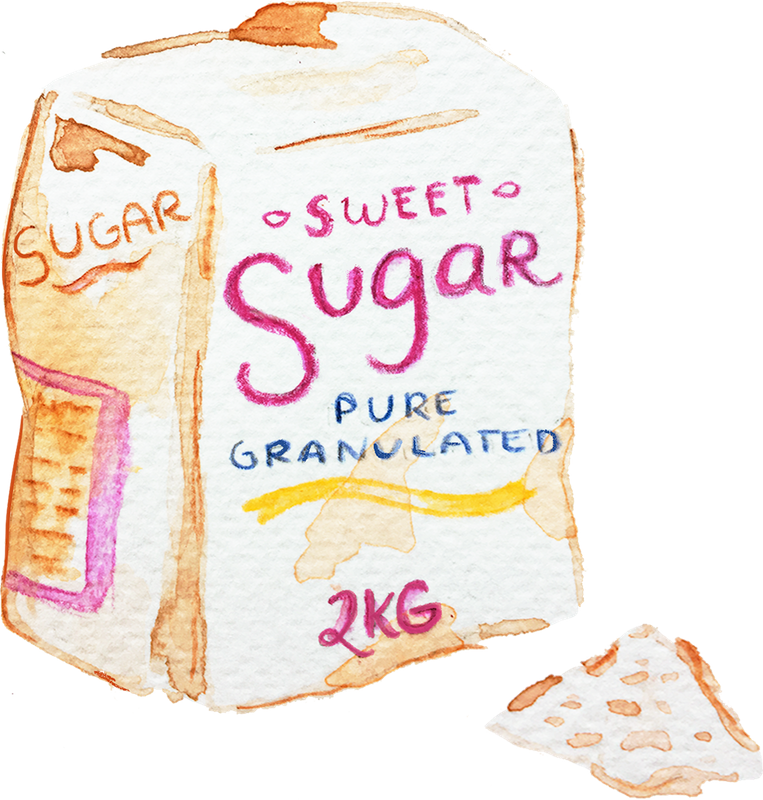
Sour facts about sugar!
Mood swings, hormone imbalance, excess sweating, energy dips, reduced resistance to stress and fat deposits around the middle are all associated with eating too much sugar. If these complaints sound familiar, they’re also common menopausal symptoms!
Why do we eat so much sugar? Because it tastes nice and quite simply it’s addictive. One recent study found that sugar caused reactions similar to cocaine! This will not come as a surprise if you’re struggling with addictions to all thing sweet. If you want to go straight to my tips for reducing it as painlessly as possible, scroll down to the end!
“Pure, white and deadly” is the title of a 1970s’s book, not much noticed at the time, about the negative effects of sugar on our health. 50 or so years later its predictions are coming true.
Sugar is now officially scientifically linked with health issues such as cancer, inflammation and diabetes. It will also make the menopausal hormone ride much, much worse!
“Natural” sugar versus added sugar
First it is important to understand the difference between “added sugar” or free sugar and intrinsic sugar.
- Naturally occurring or intrinsic sugars includes sugars in for example, grains, dairy, fruit and vegetable. In this form the sugar occurs as part of the whole structure of the food, along with fibre and nutrients.
- Generally speaking, naturally occurring sugars eaten as part of whole food are better for you because the sugar is broken down and digested more slowly by the body.
- On the other hand, there is no nutritional need for carbohydrates from “added sugar” which is highly concentrated and processed and is released into the blood quickly which puts stress on the body. Food labels don’t distinguish between added sugar and naturally occurring sugar which is not helpful.
Different words for Sugar
As well as the obvious table sugar (sucrose) used to sweeten food or drinks, added sugar may appear in food as agave nectar, brown rice syrup, honey, fruit juice, jam, glucose, dextrose, fructose, invert syrup, corn syrup, maple syrup, raw brown sugar, treacle.
How Much is Too Much?
- Government recommendations for our total maximum daily added sugar (free sugar) levels are set at 30g (19g for children aged 4–6) which is roughly 7 teaspoons. This is almost the amount of sugar you will find in just one brand of gluten free chocolate muffin or half a bar of 70% dark chocolate plus 4 dark chocolate covered rice cakes!
- When looking at food labels, more than 22.5g of total sugars per 100g is high
- 5g of total sugars or less per 100g is low.
- 1 teaspoon of sugar is roughly 4g so if you want to work out the sugar content in teaspoons when looking at food labels, divide the figure for the sugar content by 4 . You will see how easy it is to exceed the 90g daily limit. One can of coke contains 33g and a Mars Bar 32g.
What about Fructose?
Fructose is fruit sugar, it has a lower glycaemic index than glucose and is sweeter so less calorific. Fructose is found in fruit and vegetables especially root and this type of naturally occurring fructose comes with fibre and a range of vitamins and minerals. It is fine as part of a balanced diet.
This type of sugar, whilst better for you than added sugar, will still count towards the total daily sugar intake (of around 90g).
Added Fructose is Bad News
If fructose is isolated and added to foods it is going to fall into the “added sugar” category. This could be in the form of high-fructose corn syrup (HFCS), agave nectar (which actually contains more fructose than HFCS), honey, brown rice syrup molasses or maple syrup. This type of added fructose is increasingly being found to be problematic to health. It turns much more quickly into fat than other types of sugar. It also leads to reduced activity of the hormones insulin and leptin which have a strong impact on appetite and food intake.
What About Alcohol?
Don’t forget alcohol will increase your daily sugar intake. Dry white or red wine or spirits with soda water as a mixer are the lowest sugar options.
Tips for Reducing Sugar
- Try cutting out sugar containing foods for one month to break the addictive cycle. Then re introduce on an occasional basis.
- When following recipes halve the amount of sugar suggested. This works for most recipes except jam, ice cream and meringue.
- Choose dark chocolate as your sweet treat which contains less sugar, no dairy or gluten and more antioxidants.
- Try this easy recipe for chocolate coconut energy crunch bars or these double choc mint energy balls!
- Alternate alcoholic drinks with sparkling or still water especially in hot weather to avoid drinking more alcohol because of thirst.
- Mixers can be very high in sugar – use soda water
- Avoid liqueurs which are extremely high in sugar (cocktails are often a sugar rich mix of liqueurs and high sugar mixers). See these healthy mocktail recipes (pick the lowest sugar ones)
- If you are going for sugar substitutes choose a pure stevia and use sparingly. Sugar alcohols such as xylitol and erythritol (which is often found mixed with stevia) have the advantage of being extremely low in calories and a minimal impact on blood sugar levels. They are much preferable to artificial sweeteners. But the reason they don’t impact blood sugar levels is that they are not absorbed in the body hence they can sometimes cause gas and bloating.
